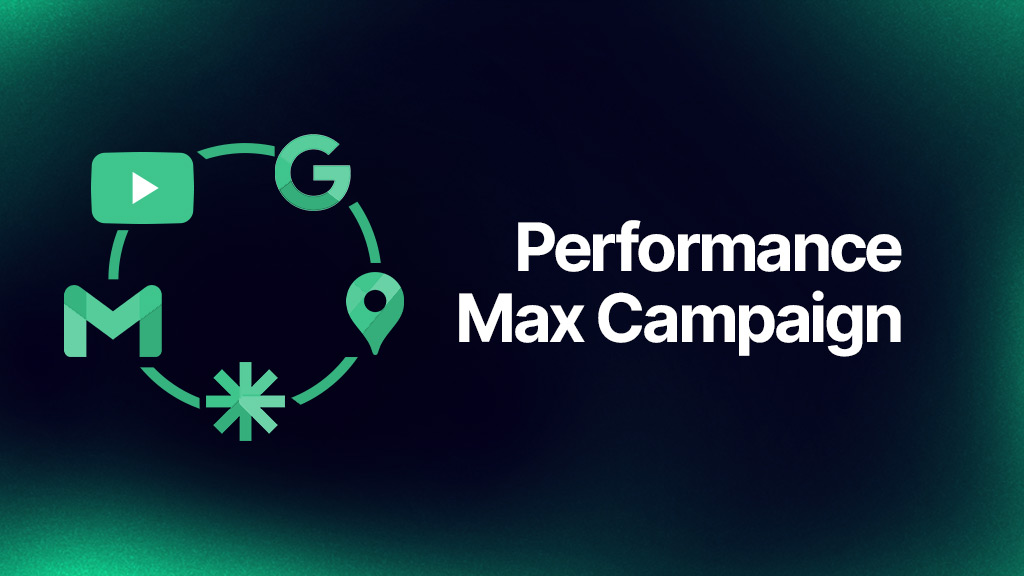Performance Max Campaign

Table of Contents
- What is a Performance Max Campaign?
- How to Create a Performance Max Campaign?
- What Are the Benefits of Using Performance Max?
- How to Optimize Performance Max Campaign?
In the fast-paced digital advertising world, stayingoogle performance maxg ahead requires embracing cutting-edge strategies. One such game-changer is the Performance Max Campaign (PMax), a powerful tool introduced by Google. This campaign style offers businesses a smart and efficient way to connect with their target audience across various Google platforms.
Let’s dive into the basics of the Performance Max Campaign, exploring what it is, the insights you get from its reports, how to set it up, the benefits it brings to advertisers, and smart strategies for optimizing campaign performance. Join us on this journey to uncover the potential of Google Performance Max Campaigns in taking your digital marketing to the next level.
What is a Performance Max Campaign?
You may wonder what is performance max Google Ads. Performance Max Campaigns in Google Ads are the ultimate example of Google’s dominance as the world’s largest search engine. It is not just another advertising campaign; it’s the result of years of data collection on users’ browsing and purchasing behavior. This rich data group empowers Google to create a campaign precisely tailored to individual searches, making it a standout feature in the digital advertising world.
Unlike conventional campaigns that limit ads to specific inventory types, such as search results or product listings, Performance Max Campaign takes a revolutionary approach. Advertisers can upload various assets, ranging from text and videos to feeds and images, and gain access to all of Google’s ad placements, all from a single campaign.
Performance Max Campaigns in Google Ads allows advertisers to access all types of creative assets:
- Text: Create engaging text ads to express your message effectively.
- Videos: Engage your audience with dynamic video content.
- Feeds: Showcase your products dynamically through custom feeds.
- Images: Grab attention with visually eye-catching images.
This diversity enables advertisers to create a more engaging and tailored advertising experience, reaching users across the Google Ads pmax ecosystem in multiple formats.
Performance Max Campaigns Google Ads was carefully developed, starting with limited availability during its alpha stage in 2020 and beta testing in 2021. After all of this fine-tuning, Performance Max Google Ads was finally released to the larger Google Ads community in 2022, just in time for the busiest shopping season.
Google’s commitment to Performance Max extends beyond its first release. The platform has seen continuous support and improvement with the introduction of new features. Noteworthy additions include brand exclusions, allowing advertisers more control over where their ads appear, and asset group-level reporting, providing deeper insights into the performance of different creative assets.
In essence, Google PMax is not just a campaign; it’s also a dynamic and evolving tool that empowers advertisers to reach their audience in more ways than ever before.
What Do Performance Max Reports Include?
Reporting stands as a critical component for agencies to showcase campaign success and impress clients with visible results. Google, recognizing the significance of accurate reporting, has actively refined its approach to address the evolving needs of agencies.
In 2021, Google Performance Max ads reporting had its limitations, allowing agencies to report on top-level campaign performance, performance by location, and performance by time of day and day of the week. While providing valuable insights, this structure may have been improved.
In 2022, Google took a significant step forward by introducing Placement Reports to Performance Max. This addition allowed agencies to gain visibility into where their clients’ ads were placed and the number of impressions received. This detailed insight marked a significant improvement in understanding campaign performance.
Performance Max Reports now offer a more comprehensive view of campaign performance, addressing some of the limitations observed in the past. The evolving nature of these reports signifies Google’s commitment to continuous improvement and responsiveness to the needs of agencies.
As we understand what the PMax Google campaign is and what its reports include, we can continue exploring how you can create a Performance Max Campaign in the next section.
How to Create a Performance Max Campaign?

Do you wonder how you can create a Performance Max Campaign or how do Performance Max campaigns work? Launching a successful PMax Campaign requires a comprehensive and detailed approach. Let’s dive into the essential stages to set up your Performance Max campaign:
1. Define Your Campaign Objectives
Start by precisely defining your campaign objectives. Whether it’s increasing website traffic, driving conversions, or boosting brand awareness, a clear goal sets the stage for a focused and purposeful campaign.
Clearly define measurable goals, such as increasing online sales by a specific percentage. Choose the campaign objective that aligns with your broader marketing goals. Also, tailor goals based on the preferences and behaviors of your target audience.
2. Select a Campaign Type
In this step, choose a Performance Max Campaign type that aligns precisely with your marketing goals. Performance Max offers various types tailored to different objectives, such as maximizing conversions or achieving a target return on ad spend (ROAS).
Consider the nature of your target audience, the lifecycle of your business, and the available campaign types, opting for one that best suits your objectives. This decision ensures a strategic and effective approach to your campaign.
3. Select Your Conversion Goals
In this step, specify clear and measurable conversion goals aligned with your marketing objectives. This enables you to track and assess the success of your campaign with precision. Also, identify the specific user actions that align with your campaign objectives, such as form submissions, purchases, or app installations.
Analyze the typical user journey on your website or app. Choose conversion goals that seamlessly fit into this journey, guiding users toward meaningful interactions with your brand. This step ensures a more targeted and results-driven approach.
4. Define Your Bidding Strategy
Fine-tune your campaign by optimizing the bidding strategy. Leverage Google’s cutting-edge automated bidding technology, Smart Bidding. This ensures dynamic and real-time adjustments to maximize the efficiency of your budget.
Select a bidding strategy that aligns seamlessly with your allocated budget and overall Performance Max campaign goals. Explore different bidding strategies to find the one that best suits your campaign.
5. Campaign Settings
Configure the settings for your PMax campaigns to ensure it aligns with your overall strategy. This includes parameters such as budget allocation, targeting options, and scheduling to tailor the campaign to your specific needs.
Specify geographical locations for targeted reach. Tailor your campaign to specific regions, cities, or countries to ensure relevance to your audience. Also, select the languages according to your target audience. This ensures that your campaign resonates effectively with users in their preferred language.
6. Generate Your Campaign Assets
Creating attractive assets is an important aspect of your Performance Max Campaign. Develop engaging and diverse assets to captivate your audience. This includes creating persuasive ad copy, visually appealing images, dynamic feeds, and compelling videos.
Create these assets with your campaign objectives and target audience in mind, to ensure a cohesive and impactful visual and textual presence. Ensure that your assets are responsive across different devices and screen sizes. This guarantees a consistent and appealing presentation regardless of the user’s device.
7. Create Asset Groups
Organize your assets into strategic groups to facilitate effective testing and optimization. Create multiple asset groups to test different combinations of text, images, and other elements. This experimentation helps identify the most effective combinations for your campaign.
Tailor asset groups to specific audience segments. Consider the preferences and behaviors of different groups, creating asset combinations that resonate with each segment. This step improves your ability to refine and improve the overall effectiveness of your PMAX ads.
By carefully following these steps, you can create a strong and successful Performance Max Campaign. From setting clear goals to optimizing bidding strategies and creating engaging assets, each step contributes to the overall success of your digital marketing efforts. In the following section, we’ll explore the benefits of using Performance Max.
What Are the Benefits of Using Performance Max?

Using Performance Max campaigns can significantly increase the efficiency and effectiveness of your digital advertising efforts. Let’s explore how advertisers can benefit from Performance Max:
Maximized Reach
Performance Max offers advertisers a comprehensive platform to extend their reach across a wide range of Google’s advertising channels. These channels include but are not limited to Search, Display, Discover, Maps, Gmail, and YouTube. By using the extensive reach of these platforms, advertisers can effectively connect with potential customers at various touchpoints throughout their online journey.
With the Performance Max campaign’s optimized reach capabilities, advertisers can reach a wider audience and improve their brand’s overall visibility and engagement.
Goal-Oriented Campaigns
Performance Max offers advertisers the flexibility to set specific conversion goals that are closely aligned with their business objectives. Whether the goal is to increase website visits, drive online sales, generate performance max lead generation, or encourage app installations, advertisers can align their campaigns with their desired outcomes.
By allowing advertisers to define clear and measurable conversion goals, Performance Max ensures that advertising efforts are focused and purposeful. This goal-oriented approach enables advertisers to direct their resources towards activities that are most likely to drive meaningful results for their business.
Automated Bidding
Performance Max campaigns take advantage of automated bidding through Smart Bidding, Google’s advanced technology driven by AI. Smart Bidding optimizes ad performance in real-time across all channels by automatically adjusting bids based on various factors such as user behavior, device, location, and time of day.
This automated optimization ensures that advertising budgets are used efficiently to increase the likelihood of achieving campaign goals while reducing wasted spend. Advertisers can save time and resources while achieving better results by using automated bidding, allowing them to focus on strategic decision-making and campaign optimization.
Comprehensive Reporting
Performance Max provides advertisers with powerful reporting capabilities that provide detailed insights into all aspects of campaign performance, audience engagement, and conversion metrics. These detailed reports serve as a valuable tool for advertisers to track key performance indicators (KPIs), analyze trends, and identify areas for optimization.
Advertisers gain access to many kinds of data within the PMax reporting dashboard, providing an in-depth view of their campaign’s effectiveness. By using these data-driven insights, advertisers can make informed decisions to optimize their campaigns for better results.
Audience Targeting Precision
Performance Max campaigns provide advertisers with advanced audience targeting capabilities, allowing them to refine their targeting using Audience Signals. These signals include demographics, interests, behaviors, and more, providing advertisers with advanced insights into their target audience’s characteristics and preferences.
Advertisers can create highly targeted campaigns that reach specific audience segments most likely to be interested in their products or services. Precision targeting ensures that ads are relevant and engage with the intended audience, increasing the likelihood of engagement and conversions.
Scalability and Adaptability
Performance Max campaigns offer advertisers the flexibility to scale their advertising efforts according to their business growth and expansion plans. Advertisers can easily expand their reach to new audiences or markets by taking advantage of the scalability of Performance Max campaigns.
Whether it’s targeting additional geographic regions, introducing new product lines, or reaching out to different customer segments, Performance Max provides the tools and capabilities to scale campaigns effectively.
Also, Performance Max campaigns are highly adaptable, allowing advertisers to respond swiftly to changes in business needs, market conditions, or consumer behaviors. Advertisers can make adjustments to their campaigns in real-time, optimizing targeting strategies, creative assets, or budget allocations as needed.
Finally, Performance Max offers advertisers a comprehensive set of tools and capabilities to maximize the effectiveness of their digital advertising efforts. Advertisers can achieve their business objectives and drive meaningful results thanks to useful Performance Max features from maximizing reach and engagement to optimizing performance and refining targeting.
As we uncovered the benefits of Performance Max campaigns, we’ll talk about how you can optimize your PMax ad campaigns in the next section.
How to Optimize Performance Max Campaign?

Performance Max Campaign optimization is important for increasing its effectiveness and achieving desired results. Here’s a comprehensive guide on how to optimize your Performance Max Campaign:
1. Understand the Key Performance Indicators (KPIs)
Before diving into optimizing your Performance Max Campaign, it’s important to have a clear understanding of the key performance indicators (KPIs) that align with your campaign objectives. These KPIs serve as benchmarks for measuring the success of your campaign and guide your optimization efforts.
Common KPIs include click-through rates (CTR), conversion rates, cost per conversion (CPC), return on ad spend (ROAS), and overall campaign performance metrics. By understanding the significance of each KPI and how they relate to your campaign goals, you can prioritize your optimization efforts accordingly.
For example, if your primary goal is to increase website conversions, you would focus on optimizing your campaign for a lower cost per conversion (CPC) and higher conversion rate. Similarly, if your goal is to improve brand awareness, you may prioritize metrics such as impressions and click-through rates (CTR) to assess the reach and engagement of your ads.
Regularly monitoring and analyzing these KPIs will allow you to track your campaign’s progress, identify areas for improvement, and optimize your Performance Max Campaign for maximum effectiveness.
2. Ensure Accurate Conversion Tracking Implementation
Accurate conversion tracking is important for effective campaign optimization in Performance Max. It allows you to precisely measure the impact of your advertising efforts by tracking user actions, such as purchases, sign-ups, or form submissions. To ensure accurate conversion tracking implementation, start by verifying that the conversion tracking code is correctly installed on your website or app.
Next, set up conversion actions within your Google Ads account that align with your campaign objectives. Define clear conversion events that represent valuable actions taken by users, and assign them appropriate values to reflect their significance. This step ensures that every conversion is accurately attributed to the corresponding ad interaction.
Regularly test your conversion tracking setup to confirm its accuracy and reliability. Use tools like Google Tag Assistant or Google Analytics to validate that conversion tracking tags are activating correctly and capturing relevant data. Additionally, perform test conversions to verify that tracked conversions are recorded accurately in your Google Ads account.
By ensuring accurate conversion tracking implementation, you can confidently evaluate the performance of your Performance Max Campaign and make data-driven decisions to optimize its effectiveness.
3. Optimize Bidding and Budget Strategy
Optimizing your bidding and budget strategy is crucial for increasing the efficiency and effectiveness of your Performance Max Campaign. Begin by analyzing performance data and adjusting your bidding strategy to align with your campaign goals.
Experiment with different bidding strategies, such as target CPA (cost-per-acquisition) or target ROAS (return on ad spend), to find which one works best.
Simultaneously, optimize your budget allocation to ensure that resources are allocated effectively across campaigns and ad groups. Monitor spending trends and adjust budget allocations based on performance insights. Consider reallocating the budget towards high-performing campaigns or audience segments to maximize ROI.
Regularly review and refine your bidding and budget strategy based on ongoing performance analysis. By continuously optimizing your bidding and budget strategy, you can drive better results and maximize the impact of your Performance Max Campaign.
4. Check Automated Assets Settings
Reviewing and optimizing automated asset settings is essential for increasing the performance of your Performance Max Campaign. Ensure that all automated ad formats, such as dynamic ads, responsive search ads, and image ads, are configured correctly to capitalize on their full potential.
Verify that automated asset selection is aligned with your campaign objectives and target audience. Regularly monitor and adjust automated asset settings to optimize ad relevance, engagement, and conversion rates. By keeping a close eye on automated asset settings, you can increase the effectiveness of your ads and drive better results for your campaign.
5. Refine Creatives
Continuous refinement of your ad creatives is essential for maintaining relevance and increasing engagement in your Performance Max Campaign. Test different images, headlines, ad copy variations, and calls-to-action to identify what resonates best with your audience.
Analyze performance metrics such as click-through rates, conversion rates, and ad engagement to determine which creatives are most effective. Use this data to improve your creative assets, focusing on elements that drive the highest levels of engagement and conversions.
Regularly refresh your creative assets to prevent ad fatigue and ensure that your ads remain attractive and impactful. By refining your creatives based on performance insights, you can optimize the effectiveness of your ads and drive better results for your campaign.
6. Use High-intent Audience Signals
Leverage high-intent audience signals to target users who are most likely to convert and engage with your ads effectively in your Performance Max Campaign. These signals include past website visitors, previous purchasers, users who have engaged with your ads or content, and those exhibiting specific behaviors indicating purchase intent.
Use audience targeting options such as remarketing lists, customer matches, and similar audiences to reach users with high purchase intent. Tailor your ad messaging and offers to speak to these audiences, addressing their specific needs and preferences.
Regularly analyze audience performance metrics and adjust targeting parameters based on performance insights. By focusing on high-intent audience signals, you can increase the likelihood of conversions and optimize the effectiveness of your Performance Max Campaign.
7. Monitor Performance Regularly
Regularly monitor the performance of your Performance Max Campaign to stay informed about its effectiveness and identify any areas for improvement. Keep a close eye on key performance indicators (KPIs) such as click-through rates, conversion rates, and return on ad spend (ROAS).
By monitoring your campaign’s performance on an ongoing basis, you can quickly detect any changes or trends and take appropriate action to optimize your strategy. This proactive approach allows you to stay ahead of the curve and ensure that your campaign is delivering the desired results.
Additionally, regular monitoring allows you to identify and address any issues or challenges that may occur, minimizing any negative effect on your campaign’s performance. Overall, continuous monitoring is essential for optimizing the performance of your Performance Max Campaign and maximizing its effectiveness in achieving your advertising goals.
Optimizing your Performance Max Campaign requires a strategic approach and continuous refinement. You can maximize the effectiveness of your campaign and drive better results by understanding your campaign’s key performance indicators, ensuring accurate conversion tracking implementation, optimizing bidding and budget strategy, checking automated assets settings, refining creatives, and leveraging high-intent audience signals.
Regular monitoring and analysis of Google PMax campaign performance metrics are essential for identifying areas for improvement and making data-driven optimizations to achieve your advertising goals. With careful optimization and strategic refinement, you can reach success with Google Ads Performance Max Campaigns.
To sum up, the Performance Max Campaign presents a significant opportunity for advertisers to improve their digital marketing efforts. By leveraging its capabilities and implementing strategic optimization techniques, businesses can achieve the full potential of Performance Max ads and remarkable results in their advertising efforts.

When to Use Performance Max Campaign?
Performance Max Campaign is ideal when advertisers aim to increase conversions across various Google advertising channels efficiently. It’s suitable for businesses seeking to maximize their reach and drive meaningful results using automated bidding technology and machine learning. Performance Max is particularly beneficial for campaigns focused on achieving specific conversion goals, such as website visits, online sales, lead generation, or app installations.
How long does it take for Performance Max to work?
Results with Performance Max can vary, but initial effects may be seen within days to weeks. Full optimization and significant results may take additional time as the campaign gathers data and adjusts bidding strategies. Regular monitoring is crucial for assessing progress.
Does Performance Max Campaigns Affect Other Campaigns?
Performance Max Campaigns operate independently and typically do not directly affect other campaigns. However, they may indirectly influence overall advertising performance by competing for ad impressions and budget allocation within the Google Ads ecosystem. Advertisers should monitor campaign performance across all campaigns to ensure optimal results and make adjustments as needed.
What is the Difference Between Performance Max vs. Smart Shopping?
Performance Max campaign is a goal-based campaign aimed at increasing conversions across various Google advertising channels, utilizing automated bidding and machine learning. Smart Shopping campaigns, tailored for retail advertisers, focus on promoting products across Google platforms with features like automated product feeds and dynamic remarketing.
What are the Best Practices for Performance Max Campaigns?
Best practices for Performance Max Campaigns include setting clear conversion goals aligned with business objectives, ensuring accurate conversion tracking, continuous monitoring and optimization of bidding and budget strategy, regular review and refinement of ad creatives, leveraging high-intent audience signals, and staying updated with Google Ads features for optimization opportunities.




How Are You
Woah! I’m really loving the template/theme of this blog. It’s simple, yet effective. A lot of times it’s challenging to get that “perfect balance” between superb usability and appearance. I must say you’ve done a superb job with this. Additionally, the blog loads super quick for me on Safari. Outstanding Blog!
Best Regards
We are very glad that you are satisfied. We will continue to share articles like this with you.